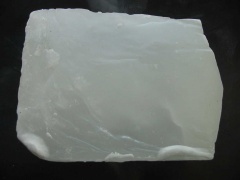Paraffin
| Infobox on Paraffin | |
|---|---|
| Example of Paraffin |  |
| Facts | |
| Origin | - |
| Stowage factor (in m3/t) | - |
| Humidity / moisture | - |
| Ventilation | - |
| Risk factors | See text |
Paraffin
Description
Paraffin, white, more-or-less translucent, odourless, tasteless, waxy solid. It melts between 47°C and 65°C and is insoluble in water but soluble in ether, benzene, and certain esters. Paraffin is unaffected by most common chemical reagents but burns readily in air. Obtained from petroleum during refining, it is used in candles, for coating paper, and for various other purposes. Chemically, paraffin is a mixture of high-molecular-weight alkanes, i.e., saturated hydrocarbons with the general formula CnH2n+2, where n is an integer between 22 and 27.
Shipment / Storage / Risk factors
Shipped as a liquid in heated tanks.
Loss of volume may occur due to the relatively high freezing point of paraffin. Solidified paraffin will adhere to pipelines, walls and floor of the tank and can only be discharged with considerable difficulty and corresponding losses.
Contamination may occur from dirty pipes or leakage from other cargoes. Oxidisation may occur in tanks not fully loaded. This can cause discolouration and will raise the acid content, leading to reduction in value and possible re-processing.
Reference is made to the relevant IMO publications on hazardous cargo.











